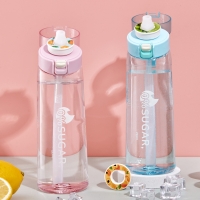Buy a water bottle, teach you these methods
Buy a water bottle, teach you these methods
As the saying goes, water is the source of life, but we may not know that the cup that holds water is equally crucial.
As the weather gradually cools down, many people like to use stainless steel cups to hold hot water and make tea. Stainless steel cups are resistant to rust, wear, and are not easily broken. They are commonly used as insulated cups and have become the preferred choice for modern people's cups.
But because it belongs to alloy products, it may contain a lot of heavy metal substances such as chromium and manganese.
Under normal use, the precipitation of chromium in stainless steel cups that meet national standards is extremely low, so there is no need to worry about its impact on health.
But the quality of stainless steel water bottles varies, and the worse the quality, the more susceptible they are to corrosion because the protective film is damaged and chromium, especially hexavalent chromium, is released.
But how can we judge the quality of stainless steel products?
Method 1: If you cannot distinguish whether the cup you bought is qualified with a magnet, let me teach you how to use a regular magnet to also distinguish the quality of stainless steel.
If stainless steel products have strong magnetic properties, it proves that they are almost pure iron. Since they are iron and have such a bright appearance, it means that they are electroplated products, not real stainless steel.
Real stainless steel products also contain iron and have a little bit of magnetism, but the magnetism is relatively weak. On the one hand, this is because the iron content is relatively low, and on the other hand, after surface coating, it has the characteristic of preventing magnetism.
Method 2: Pour lemon juice onto the surface of stainless steel products using lemon. After ten minutes, dry the lemon juice. If there are obvious marks left on the surface of the stainless steel product, it indicates that the quality of the stainless steel product is poor and it is prone to corrosion, thereby releasing chromium that is harmful to human health.
Several methods for selecting cups:
It is prohibited to choose high borosilicate glass as the material for glass cups because it is more heat-resistant and wear-resistant than ordinary glass; Observing the thickness of the glass, glass cups come in different thicknesses. We try to choose relatively thick glass cups as they have better insulation effect, are less likely to get hot, and of course, are more wear-resistant; Check if the craftsmanship of the glass cup is fine. If there are impurities or bubbles in the glass cup, it not only affects its appearance, but also its processing technology is not very good.
If you observe plastic cups carefully, you will find that there is usually a triangular mark on the bottom of the plastic cup, and the numbers inside represent different materials: those marked with PET logo represent resistance to 65 degrees Celsius and cold resistance to -20 degrees Celsius; Items marked with the PP logo are suitable for use in preservation boxes and microwave ovens; Items marked with the 'Other' symbol can be used for direct drinking water bottles, baby bottles, etc.
Ceramic cups must be purchased with colorless inner walls, not colorful ones. We can gently tap the porcelain, if the sound is crisp and pleasant, it means that the porcelain body is fine and dense, and we can start buying.
If the ceramic cup is equipped with a lid, we can also try to check if the lid is tight and not wait until we go back to find out that the lid is wrong.
Stainless steel cups should be kept away from three no products. Before purchasing, check the brand, production address, and other information of the cup carefully; There are various materials of stainless steel, and it is prohibited to choose 304 steel with less chromium migration, which is not only not easy to rust, but also healthy; Looking at the insulation performance, after filling the cup with boiling water, you can touch the outside and bottom of the cup. If you feel a slight heat, then the insulation effect of the cup may not be good enough.




